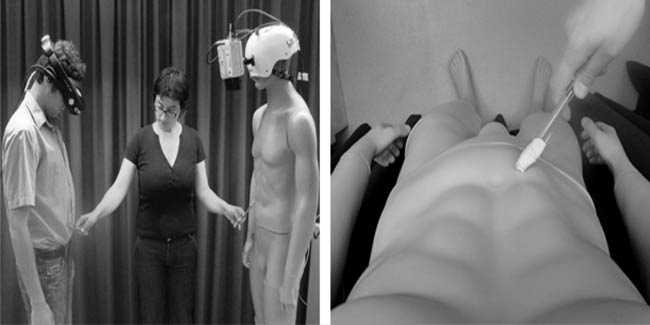Strange Experiments Create Body-Swapping Experiences

Scientists now have manipulated people’s perceptions to make them think they have swapped bodies with another human or even a "humanoid body," experiencing the sensations that the other would feel and giving the illusion of being inside the other's body. The bizarre achievement hearkens to body swaps portrayed on numerous TV shows and movies such as "Freaky Friday" and "All of Me." In real life, the cognitive neuroscientists at the Swedish medical university Karolinska Institutet succeeded in making subjects perceive the bodies of mannequins and other people as their own. The illusion also worked even when the two people differed in appearance or were of different sexes. It also worked whether the subject was immobile or was making voluntary movements. However, it was not possible to fool the subjects into identifying with a non-humanoid object, such as a chair or a large block. A year ago, scientists achieved the illusion of an out-of-body experience in subjects, using virtual reality. The new research manipulates the brain even further — out of itself and into another body. In one of the new body-swap experiments, the head of a shop dummy was fitted with two cameras connected to two small screens placed in front of the subjects’ eyes, so that they saw what the dummy "saw." When the dummy's camera eyes and a subject's head were directed downwards, the subject saw the dummy's body where he or she would normally have seen his or her own. The illusion of body-swapping was created when the scientist touched the stomach of both with two sticks. The subject could then see that the mannequin's stomach was being touched while feeling (but not seeing) a similar sensation on his/her own stomach. As a result, the subject developed a powerful sensation that the mannequin’s body was his/her own. "This shows how easy it is to change the brain's perception of the physical self," said Henrik Ehrsson, who led the project. "By manipulating sensory impressions, it’s possible to fool the self not only out of its body but into other bodies too." In another experiment, the camera was mounted onto another person's head. When this person and the subject turned towards each other to shake hands, the subject perceived the camera-wearer's body as his/her own. "The subjects see themselves shaking hands from the outside, but experience it as another person," said Valeria Petkova, who worked with Ehrsson on the study. "The sensory impression from the hand-shake is perceived as though coming from the new body, rather than the subject's own." The strength of the illusion was confirmed by the subjects' exhibiting stress reactions when a knife was held to the camera wearer's arm but not when it was held to their own. The object of the projects was to learn more about how the brain constructs an internal image of the body and how we come to feel like we are located inside our bodies, a concept called embodiment. The new experiments, the first to move beyond experiments on just a single limb, show that matching of our multisensory and motor signals from the first-person perspective is sufficient for producing the experience of owning one’s entire body, Petkova and Ehrsson write in the Dec. 3 issue of the online, open-access journal PLoS ONE. Previously, researchers thought that embodiment was sort of an inductive process of combining signals from muscles, joints and skin. The knowledge that the sense of corporal identification/self-perception can be manipulated to make people believe that they have a new body is of potential practical use in virtual reality applications and robot technology. It could also be useful in research on body image disorders. The research was supported by grants from the Swedish Medical Research Council, the Swedish Foundation for Strategic Research, the Human Frontier Science Programme and the European Research Council.
- Video – Virtual Out-of-Body Experience
- Top 10 Unexplained Phenomenon
- Gallery: Cutting-Edge Robots
Sign up for the Live Science daily newsletter now
Get the world’s most fascinating discoveries delivered straight to your inbox.
Robin Lloyd was a senior editor at Space.com and Live Science from 2007 to 2009. She holds a B.A. degree in sociology from Smith College and a Ph.D. and M.A. degree in sociology from the University of California at Santa Barbara. She is currently a freelance science writer based in New York City and a contributing editor at Scientific American, as well as an adjunct professor at New York University's Science, Health and Environmental Reporting Program.










